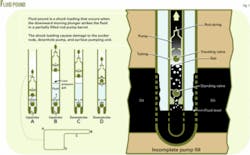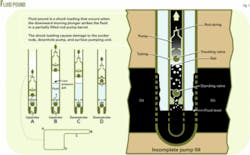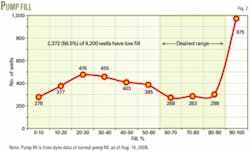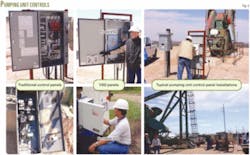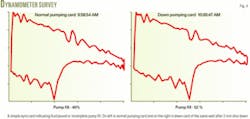A pilot project on a portable variable-speed-drive and load cell for obtaining counterbalance effect (CBE) data in the Duri steamflood improved the sucker-rod pumping efficiency from wells that had low lift efficiency caused by incomplete pump fill.
The Duri steamflood on the Island of Sumatra in Indonesia is the largest in the world and currently produces about 200,000 bo/d.
In the field, incomplete or low pump fill is the most common operational problem experienced especially on ramp-down wells. The low fill results from having a pump capacity that exceeds the formation’s ability to flow fluid into the well or from having excessive gas or steam at the pump intake.1
Excess pumping capacity creates shock loading from fluid pound (Fig. 1) that can cause rod buckling, excessive pump and tubing wear, unnecessary friction, and stress fluctuations throughout the entire pumping system.
Shock loading transmitted to the surface pumping unit may cause vibrations greater than the unit can tolerate. These vibrations may reduce equipment run life and magnify the effects of an unbalance pumping unit and gearbox overload.
Pumping problems
A major operating cost associated with sucker-rod pumping is the pulling and repair of the rods, pump, and tubing, as well as the replacement or repair of the surface pumping unit. Frequent repairs may make wells marginally economic. Repairs also decrease production because of well downtime.2
The solution to the over-pumping problem is to control the producing parameters, such as pump size, speed, frequency, and stroke length.
A reduced pump size is least effective because of its high cost.
A shorter stroke length has minimal effect on the problem and is limited because of the fixed number of crank holes, worn-out holes, and the fact that many pumping units in Duri have been set-up for a maximum stroke length.
A combination of a reduced stroke length with reduced speed, however, can deliver good results.
Pumping intermittently by placing the unit on a timer or installing a pump-off controller (POC) are the usual methods for reducing pumping frequency. Both methods have at least four drawbacks:
- Intermittent pumping changes the frequency, but not the pumping speed. When the unit comes back on, the loads associated with motion and fluid pound reoccur.
- During the downtime, liquid flows from the reservoir into the wellbore. This flow builds a liquid level in the casing that creates backpressure on the producing formation. Maximum flow occurs with minimum backpressure; therefore, the liquid column height should be kept as low as possible.
- Starting the unit from a dead stop requires more power. The start phase also induces a shock on the pumping unit, rods, and pump.
- If the well produces solids, the downtime allows the solids to settle. These solids may cause the plunger to stick more frequently.
Timers and POCs, therefore, cannot eliminate all the shocks, unnecessary pump cycles, and unnecessary power use, nor can they minimize the backpressure on the reservoir.
The faster a unit pumps, the larger the number of cycles, and the sooner the rods reach a fatigue limit. The effect is similar to flexing a wire until it breaks.
To minimize the number of pumping cycles and the stresses caused by motion, one can set the unit to pump at the slowest speed and with the longest stroke possible.
Long run times are normal with slow and steady pump strokes, making marginal wells economic for a longer time.
Duri steamflood
The Duri field uses only sucker-rod pumps for lifting fluids because these pumps can handle high fluid temperatures and sand production.3
In 1995, Duri reached a peak production of 350,000 bo/d and currently produces about 200,000 bo/d with an average steam injection of 1.017 million bbl of cold-water equivalent/day.
Most of production comes from Pertama and Kedua sands, with some areas also developed in the Rindu formation.
Fig. 2 shows that 2,372 out of a total of 4,200 producing wells or 56.5% of the wells in the field had low pump fill. This is because pumping parameters were not adequately downsized as oil production declined.
Steam breakthrough is one problem. In this case, the average wellhead temperature increases rapidly from 200° to 250° F. and is usually accompanied by a decline in oil production. Also the average reservoir pressure rises to 150-200 psi. High pressure makes lifting of fluid difficult. This condition requires close monitoring of producing wells and numerous changes to maintain normal or even pump-off conditions.
A pump-off condition means that the pump lifts all fluid supplied by the reservoir. This ideal condition occurs when the producing parameters are aligned with producing rate and at the lowest operating fluid level near the downhole pump intake.
A dynamometer survey can determine the pump-off condition. At Duri, these surveys are taken once on each well every 2 months.
The dynamometer survey also measures the pumping system efficiency, pump fill, and loading of its components. A petroleum engineer can use these data as a source for optimizing the pumping system.
There are two kinds of dynamometer surveys: simple dyno and full dyno analysis.
A simple dyno survey identifies the mechanical condition of wells and operating fluid level above the pump (Fig. 3). Full analysis measures the pumping-unit balance, structural and gear reducer loads, rod stress, power consumption, and component mechanical efficiency.
Speed optimization
Each area in the steamflood experiences production phases with rapid increase within the first few years followed by a slow decline with steam maturity. To accommodate the declining phase, the field requires aggressive optimization efforts; otherwise, the field will incur multiple failure costs related to overpumping conditions, repairs, and downtime oil lost.
Three key points in this optimization effort are: dynamometer data for analysis and candidate selection, application of VSD (variable-speed drive) for obtaining optimum pump speed at the production rate, and drive-sheave size change.
Well candidate selection starts by grouping wells according to pump fill that include plots of:
- Very low pump fill wells that are candidates for pump downsizing but are outside the scope of this project.
- Medium fill wells that are candidates for a combination of reducing pump speed and stroke length. These are in the scope of this project.
- High fill wells that are closely monitored until reaching fluid over the pump or pump fill greater or equal to 100%. At that stage, the units need an increased stroke length or speed so as not to have an excess fluid level over the pump.
One can obtain the optimum speed for producing a well at its highest rate with software simulation, but this method is not popular at Duri because of inaccuracies caused by the many assumptions made.
Variable-speed drive is the most popular method for adjusting speed to an optimum level. For the best result, these drives are installed permanently on individual wells (Fig. 4). That is ideal for accommodating rod load changes to the most suitable speed at anytime. At Duri, the plans call for installing the drives on new wells that are still in the ramp-up phase with high production rate.
For mature wells in the ramp-down phase, the drives are marginally economic. In these cases, the program is to use only a limited number of VSDs on target wells. This involves installing a VSD unit at one well for 2 days only to obtain the optimum speed. This is followed by a change in drive-sheave size.
The portable VSD combined with a dynamometer survey and sheave change costs much less then the installation of individual fixed VSDs.
Well performance before and after speed change can be compared through pre and post dynamometer analysis and well test data. For continual improvement, our petroleum engineers and technical assistants monitor and analyze all related data provided by the dynamometer survey, well test, and operator checklist.
To accommodate dynamic changes of formation fluid level, the program includes scheduled reviews of the pump speed once a year for stable wells and twice a year for ramp-down wells. Also adjustments are made if the operator notices significant changes and if the dynamometer data indicate a need.
This initiative incorporates a new pumping-unit balancing method using a load cell and load indicator. Unbalance pumping units remain a large challenge at Duri and the unbalanced units affect downtime, repair man-hours, and equipment damage, such as broken gearboxes, bearings, wrist pins, and belts, as well as motor burnouts.
Balancing a unit
At Duri, ammeters are used for balancing pumping units. The amp probe connects to the electric motor leads and measures amperage drawn by the electric motor during the pumping cycle.
The balancing procedure involves moving the counterweights until the mean amp reading on both the upstroke and downstroke are the same. This method, however, can be time consuming and often is inaccurate because it requires moving the weights an indefinite distance then securing the bolts, running the unit, and remeasure the amperage. The process often needs repeating until the technician obtains a satisfactory ampere reading.
This method can be effective if the unit already is nearly balanced. It may, however, result in a grossly unbalanced condition. Because the ammeter cannot detect whether the alternating current is leading or lagging the voltage, the motor current will indicate a positive value, regardless of whether the motor is regenerating or motoring. One may mistake regenerative currents for motoring currents, thereby, severely unbalanced the pumping unit.4
Repeatedly moving heavy weights also increases the safety hazard to technicians for the trial-and-error process.
An important consideration is that the downhole fluid level increases while the pump is down for this balancing work. A longer downtown requires longer times to normalize the load. This can lead to wrong amp readings if the load is not stabilized.
Simplified balancing calculations with a computer program is another way for balancing a unit. Output of this simulation includes the distance and direction that the weights should move and the needed pounds added or reduced. The software also contains information of crank and counterweight data for most common pumping unit brands.
But at Duri, this software has the problem that some of the pumping unit brands and models are not included in the software, making the software unusable. The software, furthermore, requires much downhole and surface data that may be unavailable.
The best alternative solution at Duri has been to use a load cell and load indicator. The load cell installed above the carrier bar records load changes to obtain counterbalance effect (CBE) data.
The CBE data is sufficient to move the counterweights the right distance during the first adjustment. This is a much faster balancing process and uses the CBE data provided in the dyno full analysis. Compared to the amp probe, the load cell method is much easier, faster, more accurate, and safer.
Results
The 10-well pilot project provided the following results:
- 40% pump speed reduction, averaging from 9.1 to 5.5 strokes/min, equaled 1.9 million stroke/unit/year less without reducing production.
- 50% vibration reduction, averaging from 0.68 to 0.32 in./sec to the safe range below 0.5 in./sec.
- Reduced and balanced gearbox loading.
- More than 20% reduction in ampere reading, which leads to energy savings and a smaller motor size from Size 3 to 2 on all 10 wells.
- 70% increase in pump fill and 79% increase in fill ratio.
- Reduction in steam interference.
By improving pump fill with a slower speed, the field reduced fluid pound and shock loading and friction wear, resulting in reduced failures and well downtime. In other words, production did not increase directly by slowing (optimizing) the speed, but rather indirectly through reduced well downtime.
After speed reduction the production trend followed the long-term decline (Fig. 5).
Acknowledgment
The authors thank the management of PT Chevron Pacific Indonesia for their permission to publish this paper. Special thanks to the production management team, well and facility maintenance, facility engineering, and our business partner PT Catur Khita Persada.
References
- McCoy, J.N., et al., “How to Maintain High Producing Efficiency in Sucker Rod Lift Operation,” Paper No. SPE 80924, SPE Production and Operations Symposium, Oklahoma City, Mar. 22-25, 2003.
- Bommer, P.M., Shauner, D., “Benefits of Slow-Speed Pumping” JPT, October 2006, pp. 76-80.
- Nagy, T.A., “Rod Pumping Optimization in Duri Field,” Paper No. SPE 22960, SPE Asia-Pacific Conference, Perth, Australia, Nov. 4-7, 1991.
- Peterson, R., “Balancing a Pumping Unit with Motor Torque Instead of Motor Current,” Oil & Gas Automation Solutions, e-newsletter, Unico Inc., October 2002.
Based on a presentation to the Simposium Nasional & Kongres IX Ikatan Ahli Teknik Perminyakan Indonesia (IATMI), Jakarta, Nov. 15-17, 2006.
The authors
Mursalim ([email protected]) is a heavy-oil production surface planning analyst for PT Chevron Pacific Indonesia in Duri-Riau, Indonesia. He previously worked on heavy equipment and steam generator maintenance.
Didi Ruchyadi is a completion engineer with PT Chevron Pacific Indonesia in Duri-Riau. He has worked as a reservoir, production, and operations engineer for the Duri steamflood. Ruchyadi has a BS and an MS in petroleum engineering from Bandung Institute of Technology.
Nibukat Zaradan is a facility engineer for PT Chevron Pacific Indonesia in Duri-Riau. He has worked on electrical design and pumping unit control and optimization. Zaradan has a BS in electrical engineering from Gadjah Mada University, Yogyakarta, Indonesia.
Budi Julianto is a petroleum engineering advisor for the production management team, heavy-oil operating unit at PT Chevron Pacific Indonesia in Duri-Riau. He has worked in primary, waterflood, and steamflood operations. Julianto has a BS in chemical engineering from Gadjah Mada University, Yogyakarta, Indonesia.
Emir Syahrir is project manager for eProduction Solution-PT Catur Khita Persada in Jakarta. His work involves reliability optimization of artificial lift and SCADA systems. Syahrir has a BS in civil and architectural engineering from the University of Trisakti, Jakarta.
